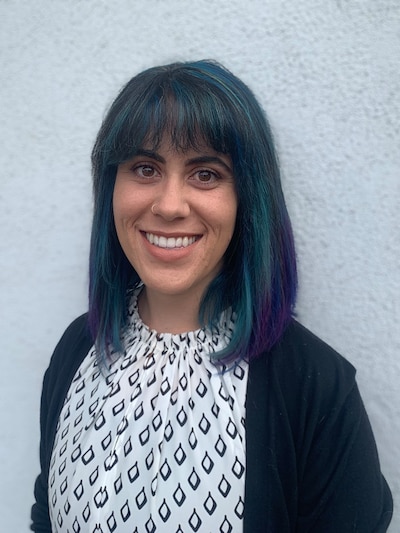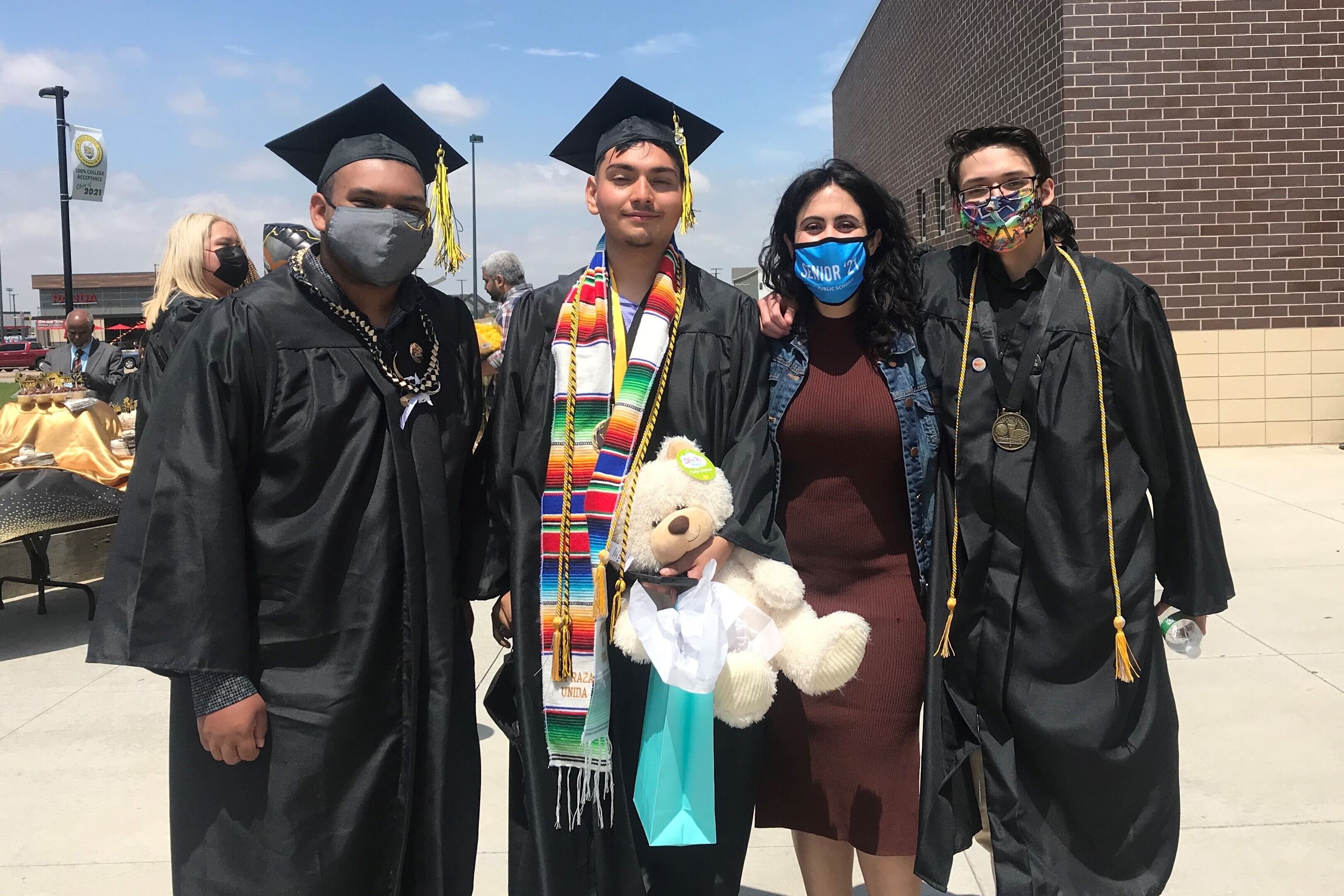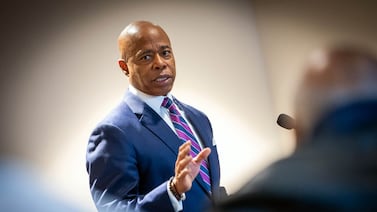During her first few years as a teacher, Alexandra Medrano corrected her students for pronouncing certain words improperly or speaking “Spanglish” — a mash-up of Spanish and English. But she noticed that lecturing them didn’t work. Students simply shut down.
“I remember catching myself saying once that my students weren’t proficient in either English or Spanish,” said Medrano, an English language development teacher at DSST: Conservatory Green High School, a charter school in northeast Denver.
“That was such a deficit way of thinking.”
Medrano soon changed course and now considers the idea that there’s one “right way” to speak a language the biggest misconception she brought to teaching. Today, she works hard to celebrate her students’ cultural and linguistic diversity.
Medrano, who participated in the 2020-21 Colorado Teaching Policy Fellows program run by the nonprofit Teach Plus, talked to Chalkbeat about why she loves teaching about Denver’s role in the Chicano movement, how the pandemic forced her to get better at using technology, and why Colorado needs to do more to retain teachers of color.
This interview has been lightly edited for clarity and length.
Was there a moment when you decided to become a teacher?

In college, I took two courses that radically changed my thinking about the U.S. public school system: ethnic studies and the sociology of education. These courses led me to reflect on my own K-12 experiences in the Placentia-Yorba Linda Unified School District in southern California.
I realized how my culture and language were rarely celebrated in the classroom, how I had been one of a handful of students of color tracked into the gifted and talented program, and how much better funded the schools in my neighborhood were in comparison to those across town, where the population was mainly Latinx.
These reflections, paired with my passion for social justice, changed my career plans, and I decided to become a teacher.
How did you reconnect with students this school year?
After a year mostly spent on computer screens, it is so important to get students talking and collaborating. My co-teacher and I were very intentional about building community and having students share with each other the first week of school.
For example, the first assignment was for students to create a “culture quilt” slide with images important to their cultures and identity. Students practiced describing the images in small groups, then presented them in front of the class. Students asked each other probing questions and wanted to learn more about each other.
Another aspect of high school that students missed last year was extracurricular activities. I believe it’s important to give these opportunities for students to develop as young adults. I often connect with students outside of the classroom by co-sponsoring student council and a Latinx affinity club, La Raza Unida.
Were there any silver linings that came out of the last year in your job as a teacher?
I have learned to integrate technology into the classroom so much more. I was never confident enough to try new techy things, but I ended up taking a lot of risks during virtual instruction to boost access and engagement.
Throughout the pandemic, teachers and districts saw huge gaps in learning and access between students of color and ... of low socioeconomic backgrounds, and white, affluent students. These gaps existed before, but they could not be ignored any longer. A silver lining is that teachers truly believe that we cannot continue perpetuating these inequities. Things cannot go back to “normal.”
You co-teach courses on U.S. history and world history that integrate English language development. How do you approach instruction?
My co-teacher and I meet regularly to integrate scaffolds and explicit language instruction into our lesson plans. Each lesson has a content objective and a language objective. For example, a content objective would ask students to evaluate three policies developed during the Progressive Era, and the language objective would ask them to use the language of compare and contrast in a written paragraph to evaluate those policies.
As a result, students not only have access to the rigorous content, but they are given the tools to grow in English proficiency. All students can practice writing and sounding like historians.
Tell us about a favorite lesson you teach.
My favorite lesson to teach is about the Chicano movement in the U.S. Students read about the West High School Blowout, Corky Gonzalez, Chicano Murals in Denver and throughout the Southwest, as well as the United Farmworkers Union. They then create a presentation to share with their peers in small groups. They discuss ways that the Chicano movement contributed to the greater civil rights movement.
It is my favorite lesson because most students haven’t learned about the Chicano movement and don’t know that their hometown was central to the movement. It brings me so much joy to see Latinx students light up with pride, knowing that our community was essential to shaping modern history.
As a Teach Plus policy fellow, what project did you undertake?
I was in the working group for recruiting and retaining teachers of color. We wrote a series of recommendations for school and district leaders on best practices for retaining teachers of color.
We shared narratives from teachers of color across Colorado with recommendations based on accountability and transparency in hiring teachers of color, culturally sustaining environments, training, and advancement. We shared our findings with community groups, schools, and elected officials.
This was an exciting and emotional opportunity as I often found myself agreeing with the statements we gathered. We found that teachers of color are not supported in the same ways that white teachers are, yet we are essential in our schools. In Colorado, 50% of students identify as students of color, yet teachers of color make up less than 20% of the workforce. This is truly unacceptable, and our state needs to do more to recruit and retain teachers of color.
Tell us about a memorable time — good or bad — when contact with a student’s family changed your perspective or approach.
Last year, I called the home of a multilingual learner who completed very little during virtual instruction. His mom shared what a responsible son he was. This student, who often acted out and did not complete work, was a great older brother who cooked for his little brother, helped him with his work, and cleaned up after him, all while his mother was working.
Learning this about him gave me new insight, and I began to build a better relationship with him. As Rita Pierson says in her famous TED talk, “Every kid needs a champion.”
What was your biggest misconception that you initially brought to teaching?
I began my teaching career as a Spanish teacher, predominantly leading “Spanish for Heritage Speakers” classes. The biggest misconception I had during my first few years was that there was a “right” way to speak Spanish — or English, for that matter.
I wasn’t embracing my students’ identities and multiculturalism, nor their full linguistic abilities. After a few years, I started to realize the negative impact I had on my students when I told them that a specific word was improper, even if that is how their family said it. I would lecture them on using Spanglish in the classroom. They shut down. So I started implementing a more positive approach, and even embracing Spanglish.
When I attended the University of Colorado Boulder to earn a master’s degree in Educational Equity and Cultural Diversity, I dove deeper into the power of language and culturally sustaining pedagogy. It affirmed what I had noticed: one must celebrate cultural and linguistic diversity while also teaching the academic language that will help students achieve academic success.









